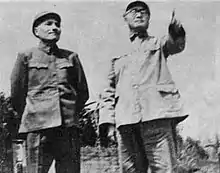
The Second Field Army (第二野战军), initially known as the Central Plains Field Army (中原野战军) or the Liu-Deng Army, was a major military formation of the Chinese Communist Party during the last stages of the Chinese Civil War.
The Second Field Army took control of PLA troops in central China, with Liu Bocheng as commander and Deng Xiaoping as commissar.[1] It comprised three armies: the 3rd Army (10th, 11th Corps, and 12th Corps) 4th Army (13th, 14th, and 15th Corps), and 5th Army (16th, 17th Corps and 18th Corps), plus a special technical column, and totalled 128,000 men. After 1949, the Second Field Army was stationed in southwest China and controlled five provinces - Yunnan, Guizhou, Sichuan, Xikang, and Tibet.
The 15th Army ("Corps") was transferred to the Second Field Army in 1950.[2]
References
- ↑ Historical Dictionary of Modern China (1800-1949), James Zheng Gao, Scarecrow Press, 2009, ISBN 0810849305, 116
- ↑ Chinese Military Science Academy (2000a), History of War to Resist America and Aid Korea (抗美援朝战争史) (in Chinese), vol. II, Beijing: Chinese Military Science Academy Publishing House, p. 249, ISBN 7-80137-392-8
External links
- PLA 1st and 2nd Field Armies 1949 Mandeep Singh Bajwa, September 6, 2007, listing of divisions in 1949, probably drawing on William W. Whitson, with Chen-hsia Huang. (1973) The Chinese high command; a history of Communist military politics, 1927–71. Foreword by Lucian W. Pye.